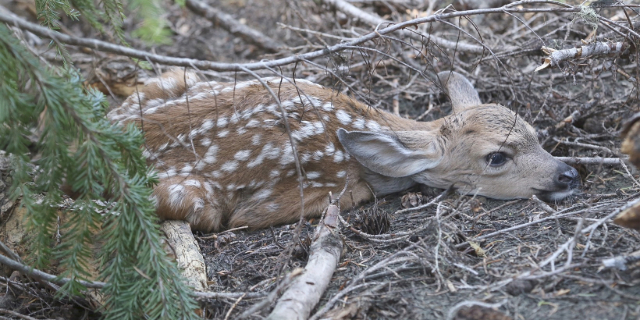Old farmer will finally be laid to rest; cremains returned to Medford family
Published 8:30 pm Sunday, November 5, 2023

- Sharon Armstrong of Medford holds a painting made by her paternal great-grandfather, Umry Henry Low. Armstrong found the painting in her family home in Jacksonville after her mother died in 2021. Armstrong later determined her great-grandfather had died — and his remains left unclaimed — at the Oregon State Hospital.
Umry Henry Low spent just six months at the Oregon State Hospital before his death at 85 on April 27, 1938. It would take another 85 years — virtually a second lifetime — before he could be laid to rest alongside his family.
Low’s ashes sat inside a weathered copper urn for most of the past eight-and-a-half decades on a dusty shelf inside a basement storage room, dubbed the “Room of Forgotten Souls,” at the old hospital.
In 2004, then-Oregon Senate President Peter Courtney discovered the roomful of copper urns. Low — one of more than 3,600 former patients whose cremains turned up — was among 76 recognized this year in an annual ceremony to return them to their families.
Born two decades after her great-grandfather drew his last breath, Medford resident Sharon Armstrong had been searching for Low’s final resting place. “I wanted to tend his grave,” she said.
A genealogy buff, Armstrong searched for marriage and death records, finally stumbling onto a state hospital memorial page hosted by FindAGrave.com, a user-created online catalogue of cemeteries around the world.
“We were only told that he left my great-grandmother when my grandpa was very young, and that he was a drinker,” she said. “It looks like the drinking was not true, according to intake information provided.”
Committed to the state hospital on Sept. 27, 1937, due to senility, Low was listed in good physical condition, save for symptoms of confusion and agitation. He had spent 63 of his 85 years in Oregon, including in Ashland and Talent. Hospital intake records listed him as married with one son.
Born in 1852, in Elkhart, Indiana, Low was one of 10 children born to Edward Low and Lucinda Foster. Following in his father’s footsteps, he was a farmer until just before his death. He was recorded in the 1860 Census, in Guthrie County, Iowa, as an 8-year-old attending school.
By 1870, he was still a student and working as a day laborer in Umatilla County. While neither of his parents could read or write, Low finished school and was a registered voter.
Census records from 1880 show a 27-year-old Low as head of household, living in southeastern Washington with his widowed mother and several siblings.
Two decades later, he and his mother lived in Wenatchee, Washington. Armstrong has yet to find records of Low living with his wife, Mary Wilcox, and his son Harry.
By 1910, Low lived alone and his mother had moved in with another son, William, in Union County. William is listed as the family member who signed Low over to the state hospital Sept. 27, 1937, at the recommendation of a McMinnville doctor.
Delivered by mail, 85 years later
Armstrong, who remembers media coverage about the forgotten cremains at the state hospital, received her great-grandfather’s cremains via U.S. Postal Service in mid-October. The Oregonian published a Pulitzer Prize-winning series of editorials, “Oregon’s Forgotten Hospital,” in 2005 that highlighted the discovery of the cremains.
Opened in 1861 as the Oregon Hospital for the Insane, the facility was featured in the 1975 film, “One Flew Over the Cuckoo’s Nest” and known for inhumane, experimental procedures, including lobotomies and work related to eugenics.
“Never, in a million years, did I think we had somebody there. … When I found him, I was stunned,” Armstrong said.
Unclaimed
Armstrong said she received Low’s remains in a ceramic urn, as well as the copper urn he’d previously been stored in. She also received his hospital records and a rubbing from the vault where he waited for so long.
A letter dated Nov. 2, 1937, from an assistant physician, responded to an inquiry from Grants Pass resident Verlie Low Haynes, Low’s niece. The assistant informed Haynes it would be “quite alright for you to send him gifts from time to time if you wish, and I believe he would appreciate it.”
Five months later, on April 27, a second letter reported Low’s physical condition as poor, that he was “gradually failing day by day.”
Haynes responded on April 30, 1938: “I want you to know how much I appreciate your kindness in letting us know, but it is impossible for me to come as our financial welfare is poor on account of sickness and I am not well. I will appreciate you letting me know of his health until he passes away or improves. … Let him know we all hope for his recovery.”
She didn’t know her uncle had already died.
Records show his brother, William Low, living in Union County, “unable to give burial instructions.” A Western Union Telegram, dated 10:08 a.m. on April 28, 1938, said, “Ok postmortem. Impossible for me to come= Wm. Low.”
Hospital staff told Haynes that her uncle’s remains would be cremated and “kept for anyone who wishes to call for them.”
Back with family
Armstrong plans to bury her great-grandpa next to her dad, Low’s grandson, Robert Lowe, at the historic Jacksonville Cemetery. The family added an ‘e’ to the last name at some point after the 1930s.
After her mother’s death in 2021, Armstrong found a painting at her parents’ Jacksonville home. The image is of a buck standing in a stream at the base of Mount Hood. Written on the back in her grandmother Mae Low’s handwriting are the words: “painted by granddad (Umry) Henry.”
She had the painting with her at the cemetery on a recent sunny afternoon. “It’s the only thing we have of his, but it shows that there was likely some contact,” said Armstrong.
Gazing around the old graveyard, Armstrong wondered if Umry Henry Low ever met her father. She may never know.
“We’ll put him to rest. … and put to rest whatever bad things happened,” she said. “He’ll finally be here, with his family.”
To see the Oregon State Hospital Memorial, visit oregon.gov/oha/OSH/Pages/Memorial.aspx






